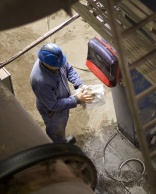Home › magazine › special features › Reducing wiper consumption
Reducing wiper consumption
27th of June 2013Wiper manufacturers obviously make more money the more products they sell. But ethical companies are developing systems all the time that prevent waste and limit the quantity of disposables that people use and throw away. We ask wiper manufacturers about their latest wiping systems that reduce both waste and over-consumption.
Disposable wipers and cloths are in widespread use in industry today. They have become an essential tool for cleaning, wiping and polishing and are used in a range of industries such as the food, healthcare, mechanical engineering and automotive sectors.
But there are two key trends in business that have had a marked impact on today’s wipes market. On the one hand there is a continued need for businesses to cut costs in order to survive the tough economic climate. And on the other there is a growing desire among companies to be sustainable and reduce waste and over-consumption where possible.
However, disposable products appear on the surface to be anything but sustainable since as their name suggests, they are designed to be thrown away after use. But disposables can be made to be more sustainable if their useful life is increased and if over-consumption is curtailed. And since this in turn helps to save money, wiper manufacturers that attempt to avoid waste and over-consumption are helping to fulfil two key customer demands.
Reducing the consumption and cost in use of wiping products are among Metsä Tissue’s key aims according to UK and Ireland sales director Mark Dewick. The company’s Less is More concept
focuses on minimising paper consumption while reducing hygiene risks by ensuring that the right product is used in the right environment.
“A wiper should deliver high absorption capacity and provide the correct sheet size for any requirement, since reduced paper consumption saves both work and money besides being better for the environment,” says Dewick. “It also saves time spent on topping up dispensers and reduces the amount of administration and paperwork that needs to be carried out. And limiting consumption also helps to cut down on transport and storage requirements.”
He says wiper dispensing systems play a major part in preventing waste and over-consumption. “Traditional dispensers are often attached to a wall which is fine in an office, but not very productive in an industrial, production or operational environment,” he said. Katrin industrial products are available on floor stands to ensure that they are at hand wherever needed and the company offers hand towels in Katrin Easy Packs to discourage industrial staff from using specialist wipers to clean their hands.
According to Dewick, customers looking for products that reduce waste and over-consumption should take into account the lifecycle of those products. “If you set about simply looking for the
cheapest solution it can often be a costly mistake,” he said.
“For example, waste issues may centre around blockage problems with old drains or vacuum toilets or with new water-saving devices. A recycled product that contains a large amount of glue can be far worse for drainage systems than a virgin fibre product, for example. And knowledge of the ‘environmental footprint’ of a recycled wiper versus a virgin fibre product is often taken out of context.”
He adds that customers do not always appreciate the difference between cost and cost in use, particularly in the case of large corporate buyers looking for the lowest price per sheet. “However, some companies and institutions are definitely more interested in the cost in use argument,” he adds. “These include, for example, schools switching to academy status; hospital trusts taking on more autonomy, hotels seeking greener solutions and FM companies exploring new ways of doing business.”
Greenspeed owner Michel de Bruin says concern for sustainability is becoming an increasingly important factor for customers when choosing a wiping product. “We use training and customer support to heighten environmental awareness,” he said.
The company’s Greenspeed Original microfibre cloth is claimed to avoid the waste issue associated with using a disposable wiper since it can be washed and reused more than 600 times. The cloth can also be folded three times, creating a total of 16 clean facets. “This means you can clean more than 600 sq m with one cloth,” said de Bruin.
“It is important to reduce consumption and waste, not only because of the enormous cost reductions you can achieve but also because it helps to save the world from negative impacts on nature.”
Vileda offers both microfibre products and ‘semi-disposable’ wipes that are designed to reduce waste and over-consumption. Scientific services customer development manager Dr Jochen Wirsching claims that the company’s microfibre cloths can be laundered more often than rival products - between 500 and1,000 times – while also consuming less electrical energy and water during laundering. “This is due to their lighter weight and lower liquid absorption properties,” he said.
The ‘semi-disposable’ wipe options - MicroRoll, Breazy and Quick ´n Dry – are claimed to offer prolonged durability compared with other disposables.
“This might sound like a contradiction, but typical usage areas for these cloths are applications requiring disposable wipers for hygiene reasons such as in food preparation environments,” said Wirsching. “Since the user can decide whether to launder or rinse the cloth instead of disposing of it immediately, this lowers both cost-in-use and the carbon footprint.”
He says there are several reasons why consumption and waste both need to be reduced these days. “Natural resources are scarce and the environment is becoming increasingly polluted, while waves of raw material price increases are hitting everybody,” he said.
“Customers are very interested in lowering their total cost in use and there is a clear trend, particularly at larger sites, that end-users are rejecting systems that generate high amounts of waste.”
PGI Nonwovens has made its own bid to reduce waste by developing a wiper that is claimed by the company to be both compostable and biodegradable. The Chicopee J-Cloth 3000 is said to achieve 95 per cent degradation after 12 weeks in an industrial composter.
“For some time we have been aware of the changing regulations regarding landfill as well as the escalating costs of waste disposal,” said regional sales manager John Whalley. “We have also noticed a general move towards the use of microfibre cloths to cut down on waste. But microfibre products are not always feasible - for example, in environments where there are no laundry facilities.
“So we wanted to introduce a product that would enable customers to dispose of their wipers either as green or food waste.”
The Chicopee J-Cloth 3000 is a surface wiper aimed chiefly at the janitorial and food service sectors. It is available in five colours to suit colour coding regimes and is sold as a single shift product to be used for three to four hours at a time before being rinsed and composted.
According to Whalley, customers are at last beginning to understand the importance of sustainability. “People are starting to look at how many consumables they are throwing away and are warming to the idea of a compostable cloth.”
Tork manufacturer SCA recently carried out a series of site surveys that demonstrated high levels of waste in environments where wipers were used. ??“We went to food factories, catering kitchens and industrial premises and saw evidence everywhere that wipers were being wasted and over-consumed,” said product and segment manager Amelia Baker. “In factories, for instance, loose rolls were often left lying around on the work surface and in one case an oil can had spilled and a wiper roll had soaked up the mess which meant the entire roll had to be thrown away.
“We also found loose wiper rolls on food preparation counters where the trailing end was left to become contaminated with bacteria. Where centrefeed rolls were in use, operatives would inevitably pull out long lengths of wiper at a time regardless of whether or not they would need all of it.
“The same applied in workshops where the only wiping source was one giant roll on a centrally-placed floor stand. Staff would take more wiper than they needed to avoid having to return to the wiping source later.”
The company’s Tork dispensers have been designed to address these problems, says Baker. Wall-mounted wiper dispensers for rolls, centrefeeds and individual sheets are tightly sealed to protect the wipers from spills or contamination before use.
“A wall-mounted wiper dispenser in a compact units that can be situated in any bay or cubicle around the workshop enables all operatives to have access to a wiping source nearby,” said Baker. “This avoids the issue of staff having to make the long trek to a centrally-placed giant wiper roll.”
She says that in today’s tough economic climate where sustainability remains top of the agenda it is important to offer systems that reduce waste and over-consumption.
“This is good for the environment while also improving cost in use,” said Baker. “Though realistically, not every customer understands the cost-in-use argument: some only care about the price per case.”











